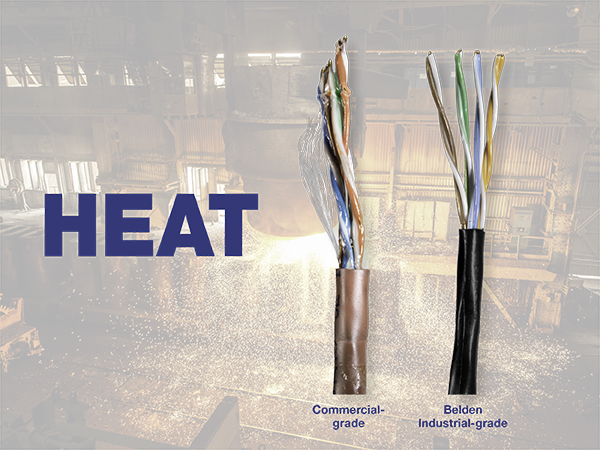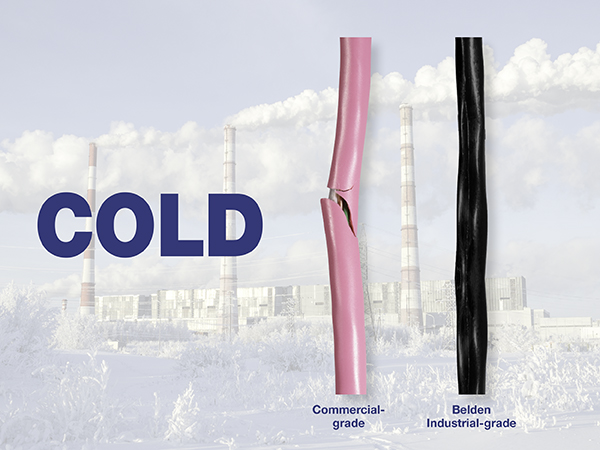Industrial Ethernet vs. Regular Ethernet: Why Does it Matter?
I’m talking grease, dust, water and unthinkable temperatures. The environment many industrial facilities operate in is significantly different from that of an office building or retail store. And yet, many (seemingly) basic functions are still expected to run smoothly, despite these conditions. Factories need to be able to transfer data from one machine to another and they need to be able to rely on their cable to perform in extreme conditions.
Durable Cable for Harsh Environments
I’m talking grease, dust, water and unthinkable temperatures. The environment many industrial facilities operate in is significantly different from that of an office building or retail store. And yet, many (seemingly) basic functions are still expected to run smoothly, despite these conditions. Factories need to be able to transfer data from one machine to another and they need to be able to rely on their cable to perform in extreme conditions.
One area that can make an incredible impact for manufacturers, either positively or negatively, is the reliability, security and strength of their networking cable. Simply using any Ethernet cable won’t work. Ordinary devices that might perform just fine in a temperature-controlled office setting won’t hold up to the extremes of an industrial environment.
Here’s a great analogy: How ridiculous would it be to place a penguin in the desert?
We all know that penguins wouldn’t thrive in a desert. They are not built for that environment. Similarly, the environment that cables are placed in makes a huge difference in their ability to function properly.
Does Ethernet Cable Quality Matter?
The short answer is, if your Ethernet cables are not meant to withstand the environment they are in, they don’t work. At least, they don’t work the way you want them to. Cables are manufactured to perform specific functions in specific environments. This includes environments that have:
When you put a commercial cable (not industrial-grade) in an industrial area of any kind, it will likely physically damage the cables, resulting in data loss and even downtime.
Cables Exposed to High UV Rays
Laboratory simulations of extremely high temperatures clearly show how Commercial-grade cable performs vs. Belden Industrial-grade cable. Exposure to high ambient temperature or High UV levels degrades the cables, and can lead to breakdown of the jacket, followed by rapid degradation of the insulation materials. This reduces signal strength with Commercial-grade cables and can cause signal failure and reliability issues.
What you’ll notice: Cables will fade in color and become brittle over time. Water ingress will happen, leading to potential equipment damage and signal failure. Signal attenuation may be higher than normal, leading to lost data transmission.

Prior to testing, jacket color was pink for commercial-grade and black for Belden industrial-grade cables.
Cables Exposed To Low Temperatures
When tested for extreme low temperatures in a series of laboratory tests, Belden Industrial-grade cables clearly outperform Commercial-grade cables. Commercial-grade cables become brittle when exposed to cold temperatures. Damage typically occurs during flex, mechanical shock and/or impact.
What you’ll notice: Cable jacket will crack if moved, exposing insulated conductors to outside contaminations like water, dust, oil, rodents and physical stresses such as crush or cut-through.

Prior to testing, jacket color was pink for commercial-grade and black for Belden industrial-grade cables.
When making decisions about what type of cable to use in a particular industrial setting, it is easy to assume “they are all pretty much the same” or to question the difference in price. However, thinking back to our penguin example, there are some combinations that don’t make any sense. Putting a non-industrial cable in an industrial environment is one of those examples. What might save you money in upfront installation will cause much more damage than it is worth.
When you choose cables for your environment, remember – industrial environments like factories, plant floors or refineries are not the same as offices. Your machines require a lot of data in order to function correctly, and by choosing cables that are made to withstand extreme temperatures, shock, vibration, grease, water and so on, you are directly increasing uptime. (And reducing headaches – and reducing rework – and reducing equipment malfunctions.)
